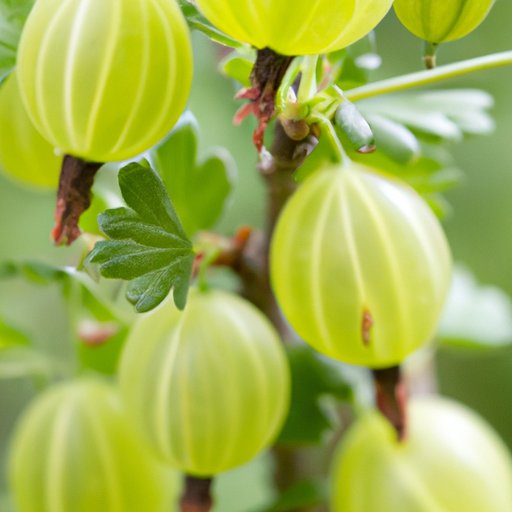I. Introduction
If you’re not familiar with gooseberries, you may be wondering what they are. Gooseberries are a type of fruit that grow on small bushes. They are typically round or oval-shaped and range in color from green to red and purple. Gooseberries are known for their tart flavor and are often used in jams, desserts, and other culinary creations. In this article, we’ll explore everything you need to know about gooseberries, from their taste and texture to their health benefits and culinary uses.
II. Exploring the Taste and Texture of Gooseberries: An Introduction
When it comes to taste and texture, gooseberries are unique. They have a tart flavor that is a cross between a grape and a green apple. The texture of gooseberries can range from firm and crunchy to soft and juicy, depending on the ripeness of the fruit.
Gooseberries are often compared to other berries like strawberries and raspberries. However, they have a much different flavor profile. While other berries are typically sweet, gooseberries are tart, which makes them great for adding a tangy flavor to recipes.
When selecting gooseberries, look for ones that are firm and plump. If they are too ripe, they may be soft or mushy. If they are too unripe, they may be sour. Gooseberries can be eaten raw, but they are also commonly used in cooked dishes like pies, crumbles, and sauces.
III. Everything You Need to Know About Gooseberries: From Health Benefits to Culinary Uses
Gooseberries are not only delicious, but they are also packed with health benefits. They are a good source of antioxidants, vitamin C, and fiber. Eating gooseberries may help boost your immune system, reduce inflammation, and improve digestion.
When it comes to culinary uses, gooseberries are versatile. They can be used in sweet and savory dishes. Gooseberries are often used to make jams, jellies, and desserts like pies and crumbles. They can also be used to make sauces for meats like chicken or pork.
If you want to use gooseberries in your recipes but can’t find them at your local supermarket, you can substitute them with other tart fruits like raspberries, cranberries, or sour cherries.
IV. Gooseberries: A Hidden Gem in Your Garden and Kitchen
If you’re a gardener or want to start growing your own fruits and vegetables, consider adding gooseberries to your garden. Gooseberry bushes are relatively easy to grow and require little maintenance. They are also perennial plants, which means they will come back year after year.
Growing your own gooseberries has many benefits. You can enjoy fresh, homegrown fruit that is free from pesticides and other chemicals. Plus, it’s a great way to save money on expensive grocery store produce.
To grow gooseberries, you’ll need to select a location with well-drained soil and partial shade. The bushes should be planted in the fall or spring, and they will typically start producing fruit in their second or third year.
When it comes to caring for your gooseberry bushes, make sure to prune them regularly to promote healthy growth and remove any diseased or damaged branches. Gooseberries are also susceptible to pest and diseases like aphids and powdery mildew, so make sure to keep an eye out for any signs of trouble.
V. From Sweet to Sour: Varieties of Gooseberries and Their Uses
There are several different types of gooseberries, each with its own unique flavor and culinary applications. Sweet varieties, like the Hinnomaki Yellow and Leveller, are often used in desserts and jams. Tart varieties, like the Invicta and Pixwell, are better suited for savory dishes like sauces and stuffing.
When selecting gooseberry varieties for your recipes, think about the tartness level you want to achieve. Sweet varieties will give your recipes a milder flavor, while tart varieties will add a more pronounced tang.
Gooseberries can also vary in color, with some varieties being green, while others are red or purple. Generally, the darker the color, the sweeter the fruit will be. However, this is not always the case, so make sure to taste-test your gooseberries before using them in your recipe.
VI. Gooseberries: A Tart and Tangy Superfood for Your Health
As we mentioned earlier, gooseberries are packed with health benefits. They are a great source of vitamin C, which is essential for a healthy immune system. They also contain antioxidants, which can help protect your cells from damage caused by free radicals.
Some studies have even suggested that eating gooseberries may help prevent certain types of cancer, lower blood sugar levels, and improve cholesterol levels.
When it comes to incorporating gooseberries into your diet, there are many ways to do so. You can eat them raw or cooked, and you can add them to both sweet and savory dishes.

VII. Cooking with Gooseberries: Recipes for Every Meal and Occasion
If you’re looking for inspiration for how to use gooseberries in your recipes, we have you covered. Here are a few delicious recipes to try:
- Gooseberry Pie
- Gooseberry Crumble
- Gooseberry Jam
- Roasted Chicken with Gooseberry Sauce
- Gooseberry Scones
When pairing gooseberry dishes with other foods, think about the tartness level of the gooseberries. If you’re serving a sweet gooseberry dessert, try pairing it with vanilla ice cream to balance out the tartness. If you’re serving a savory gooseberry dish, pair it with a mild-tasting protein like chicken or pork to let the gooseberries shine.
VIII. A Beginner’s Guide to Growing and Harvesting Gooseberries in Your Backyard
If you’re interested in growing your own gooseberries, here’s a step-by-step guide to get you started:
- Select a location with well-drained soil and partial shade
- Plant your gooseberry bushes in the fall or spring
- Water your bushes regularly
- Prune your bushes regularly to promote healthy growth and remove any diseased or damaged branches
- Harvest your gooseberries in the summer when they are firm and plump
- Store your harvested gooseberries in the fridge for up to a week
When it comes to harvesting your gooseberries, make sure to pick them when they are fully ripe. If you pick them too early, they will be sour. If you wait too long, they may become overripe or mushy.
IX. Conclusion
In conclusion, gooseberries are a tart and tangy fruit with many health benefits and culinary uses. Whether you eat them raw or cooked, gooseberries add a unique flavor to any recipe. If you’re interested in growing your own, gooseberry bushes are easy to care for and produce abundant fruit.
So why not give gooseberries a try? Whether you plant your own gooseberry bushes or experiment with a new recipe, you’re sure to find these little berries to be a hidden gem in your garden and kitchen.
